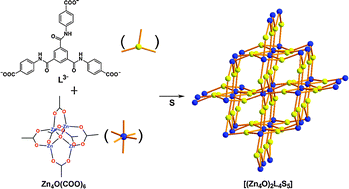A two-fold interpenetrated (3,6)-connected metal–organic framework with rutile topology showing a large solvent cavity†‡
Abstract
A two-fold interpenetrated metal–organic framework (MOF), [(Zn4O)2L4(DMF)2(H2O)3], was prepared using the tritopic ligand

- This article is part of the themed collection: Coordination polymers: structure and function

 Please wait while we load your content...
Please wait while we load your content...